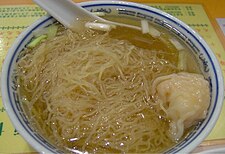Wonton noodles
This article's tone or style may not reflect the encyclopedic tone used on Wikipedia. (March 2010) |
| Wonton noodles | |||||||||||
|---|---|---|---|---|---|---|---|---|---|---|---|
 Wonton noodle (Hong Kong style) | |||||||||||
| Traditional Chinese | 雲吞麵 | ||||||||||
| Simplified Chinese | 云吞面 | ||||||||||
| Jyutping | wan4 tan1 min6 | ||||||||||
| Hanyu Pinyin | yúntūn miàn | ||||||||||
| Literal meaning | wonton noodles | ||||||||||
| |||||||||||
Wonton noodles【Mandarin: Yun-tun mian; Cantonese: Wan-tan Min】, sometimes incorrectly called wantan mee ("wanton" is a Cantonese word for dumpling while "mee" is a Hokkien word for noodles, the correct Cantonese word for noodle is "min")is a Cantonese noodle dish which is popular in Guangzhou, Hong Kong, Singapore, Thailand, and Malaysia. The dish is usually served in a hot broth, garnished with leafy vegetables, and wonton dumplings. The types of leafy vegetables used are usually kailan also known as Chinese kale. Another type of dumpling known as shui jiao is sometimes served in place of wonton. It contains prawns, chicken or pork, spring onions with some chefs adding mushroom and black fungus.
Hong Kong
In Hong Kong, wonton noodles are usually served in steaming hot soup with shrimp wontons and garnished with leafy vegetables. There are plenty of variations of this popular Cantonese dish, with different toppings and garnsihes. For example the soup and wontons in a separate bowl, the noodles being served relatively dry, with the toppings and garnishes, dressed with sauce, dipping the noodles in the soup to eat it.
There are four distinct features: First, the wontons are predominantly prawn, with low amounts of pork mince, or no pork at all. Second, aficionados will insist on fresh, smooth thin noodles which are al dente, free from the taste and odor which is characteristic in many egg noodles when cooked. Third, the bouillon is light brown (prepared from dried flounder) and is usually steaming hot. Lastly, garlic chives are used as a garnish. The first two give the dish a wet but crunchy or crispy mouthfeel. The last two give the dish a unique bouquet.
In order to ensure that the noodles are perfectly al dente and free from "noodley" taste, the cooking process and sequence must be meticulously adhered to. The wonton is cooked first, and then placed in the bowl. The noodles are blanched for only 10 seconds, after which they are rinsed under cold water and placed in the serving bowl. Piping hot bouillon is then scooped into the bowl, on top of the wonton noodles. The bouillon must be tasty, yet not so strong as to overpower the delicate taste of the wonton and the noodles which it is meant to accompany. Wonton is most popular in some China states.
When served, the spoon must be placed at the bottom, with the wontons above the spoon and the noodles on top. Because if the noodles soak in the soup for too long then it will be over cooked, this is strictly adhered to by the best wonton noodle establishments.
Although the "wonton noodle" is synonymous with wonton and noodles served in piping hot bouillon, the dish may also be served "dry", as in lo mein (撈麵), where the wonton are placed on a large bed of noodles.
Malaysia

Malaysia offers different versions of the dish, with different states having different versions of the dish and there are versions from Johor, Pahang, Perak, Penang, Sarawak, and Selangor. The Malaysian version differs from the original in having slices of char siu added to the dish, as well as the possibility of the soup and wontons in a separate bowl, the noodles being served relatively dry and dressed with oyster sauce.
Often served dry, the Hong Kong version can be found at Cantonese noodle joints with it being dry or soup. In Malacca, wontons are placed together with the noodles and wonton soup can be ordered separately. The Malacca version is also usually spicier than the other Malaysian versions due to the use of a special unsweetened chilli sauce.
Singapore
The Singapore version of wanton noodle is largely similar to the Malaysian version. It includes noodles, leafy vegetables (preferably cai-xin), Barbecued Pork (char siu) and bite-sized dumplings or wonton. It is either served dry or in soup form with the former being more popular. If served dry, the wontons will be served in a separate bowl of soup. Shui jiao or prawn dumplings are served at some stalls and the original Hong Kong version is available at Cantonese restaurants and noodle joints. Some popular wanton mee stalls are Pontian Wanton mee (Pontian being the name of a district in Johor, Malaysia), Kok Kee Wanton Noodle, and one of the most popular of all, Fei Fei Wanton Mee (simplified Chinese: 飞云吞面; traditional Chinese: 飛飛雲吞麵). Fried wontons (wontons deep fried in oil) are sometimes served instead of those boiled in the soup.
Thailand

Wonton noodles (Thai: บะหมี่เกี๊ยว; bami kiao) are also very popular in Thailand, where, as in Malaysia and Singapore, the dish is often ordered together with barbecued pork which is then called bami mu daeng kiao (Thai: บะหมี่หมูแดงเกี๊ยว; mu daeng meaning "red pork"). As is customary with many noodle soups of Chinese origin in Thailand, chillies preserved in vinegar, dried chilli flakes, sugar and fish sauce are added to taste. The dish is mostly eaten in soup form but it can also be served dry with the broth on the side.
